Building the Forshage Electric Guitar Body
Having seen an introduction to the Forshage Hollow Body electric guitar and then pictures showing Chris’ approach to making the Forshage guitar neck, it’s now time to turn to the details of the guitar body.
Let’s start with a look at the top and back pieces that will soon transform into the guitar body. The top is a lovely two piece flamed maple board and the back is mahogany. Note the chambering of the body (also see Making Electric Guitars That Won’t Break Your Back) which will lend warmth to the guitar’s tone as well as dramatically reduce its weight:
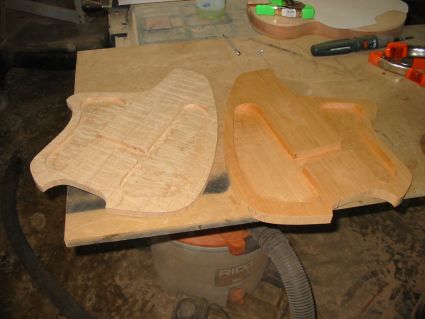
We skip ahead a bit and see the guitar body with its neck mated. The guitar body edges have been smoothed and radiused:
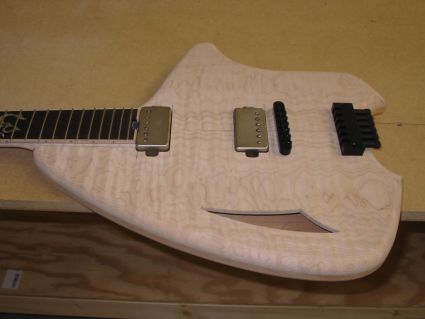
Next we see the initial staining of the top followed by coats in the paint booth:
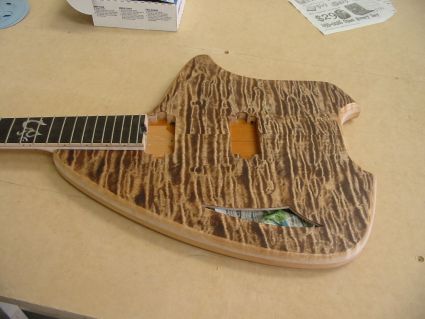
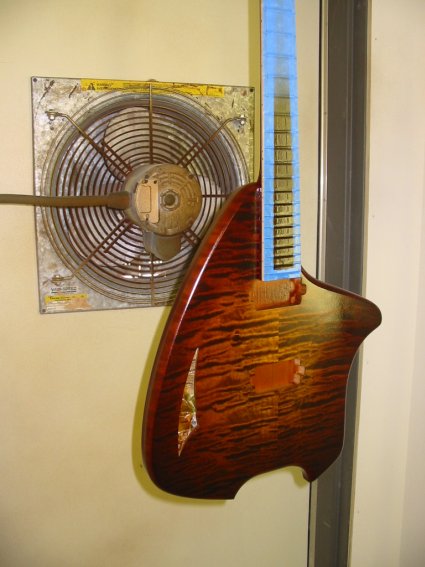
Now for the final images of the completed Forshage hollowbody electric guitar!
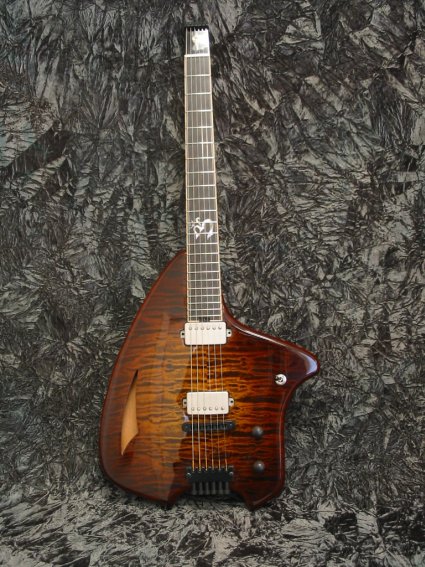

Here are a few of the specs:
- Weight – Approximately 6 lb.
- Length – 33. 75″ long (this makes for a great headless travel guitar, btw)
- Thickness – A mere 1.5″ thick
- Top Wood – Flamed maple
- Back Wood – Mahogany
- Bridge – ABM Headless Guitar Bridge
- Neck – Four piece Maple laminated neck with an ebony fingerboard
- Pickups – Tom Short’s Handmade Guitar Pickups
Once again, thanks to luthier Chris Forshage and jazz guitarist Dr. Marc Ybaben of The Marc Why Group for sharing the details of this lovely guitar.
Hi Robert!!!
Im’m planning to build a Klein copy. That brand amazed me since I saw an italian guitarist called Mauro Franchescci here in Argentina.
I’m in the eternal struggle of what bridge to use…
Do you know what is the brand name or anything about the Forshage Brand?
I have some plans I could share with you considering the Steinberger Gearles Tuners and a Gibson LP Nashville bridge. Maybe you could have a look at it and tell me some measurements about the neck or anything.
My mail is cocobest@softhome.net
Bye
Hey Carlos! Welcome! I’d be happy to take a look at your plans. I’ve actually had several folks approach me about their projects.
As far as the Forshage question, The Forshage guitar is by Chris Forshage of Forshage Custom Instruments. Chris actually doesn’t have anything on this particular guitar on his site yet but you can certainly contact him through it. Just a note – there’s a glitch on his site if you’re viewing it through Firefox where certain links don’t show up. However, it views fine in Internet Explorer.
I am on line right behind Marc for my Forshage headless hollowbody. I ordered mine in mid-September 2006 (Marc and I have exchanged emails a few times).
Chris Forshage entertains any reasonable custom options you propose. I am having mine built without the mini “headstock,” opting instead for a zero fret like a Steinberger. And the pickups will be a Gibson ’57 in the neck for jazz, with two Fralin Vintage Hot Strat pickups at middle and bridge.
I had Chris cut out wood from the top to use as pickup covers, finished to match the top. And figured maple knobs too, also finished to match. So it will be one flowing surface of quilted maple in lava orange!
Pics are sparse, but getting there:
Link: http://www.rogerplacer.com/guitars/Forshage
Roger Placer
Looking good Roger and thanks for stopping in! I like the arrangement on the Steinberger neck as well. However, it is a nice feature for those who find it a bit disconcerting to have nothing above the first fret. It’s a common complaint among those moving from conventional guitars to headless ones. Thanks again and let us know how the guitar goes.
[…] Making the Forshage Hollow Body Guitar – Robert Irizarry […]
What is the brand of the bridge on the guitar?
It’s an ABM headless bridge. Read a bit more about it here – Guitar Building Resources for Headless Guitar Designs.
Yeah! I read about that trem before. Luckyly I have a friend who lives in Germany 😆
Hi Robert,
A quick follow-up anecdote: I recently went to a guitarist-friend’s house to do some duet practicing. When I walked in with my Forshage, my friend laughed, “Haha, that’s such a little case! What is that?” I pulled it out, and his eyes got big. THen I handed it to him, and he laughed again, “Wow, it’s so light!” (He plays a 335-type guitar and a Strat)
Then he plugged it in and sat down. This is when he stopped laughing and got pretty serious. “Hey, this feels great! Everything is so close to your body. Ooh, nice sound!” I had to fight him to get it back..
More later,
Marc
Very cool, Marc! 😀 I’m looking forward to hearing more about your experiences with the Forshage.
Is the neck set or bolted in?
Also, what is that extra bit past the nut? Is that something that allows the guitar to use a standard length neck? Or is there something else that I’m not seeing?
Thanks.
It’s a set neck. As far as the extra bit past the nut, Chris includes this extension as a means of providing a transition for those guitarists who report finding themselves a bit lost low on the neck due to the lack of a headstock. I’ve never seen this as an issue but have heard other guitarists mention it. More about the neck – Building the Forshage Hollowbody Guitar – Making the Neck.
Ahh, I see. I read that in the other post but it didn’t make sense to me then.
I’m glad that clarifies things.
That’s a good idea for the behind the nut piece. If you treat the open position the same as you do your movable positions, you will often have your LH index finger behind the nut.
Does the Forshage require double-ball-end strings?
Not only does it not require double-ball strings, it actually will NOT accomodate them. The “nut” to tailpiece length is too long. At least, such is the case on my 25″ scale Forshage and a set of La Bella strings that I have for my Steinberger. And I have a zero fret with a shorter headpiece than the standard Forshage “mini” headstock.
Great observation and excellent question! I hadn’t thought to note the string situation for the Forshage but I see Roger has answered.
In case, you’re not aware, the Steinberger double ball strings are fairly short end to end. They drop in and tune up rather quickly. It’s convenient not having to worry about wrapping string around a conventional tuner. However, that’s minor in my humble opinion. What you gain is far greater choice from using conventional strings. Personally, I think that’s far more valuable.
So it has a clamping nut then?
Sort of, not technically a nut (there’s a standard nut). It’s a clamp north of the nut. On mine there is a zero fret (no nut) and a combination ball end/clamp headpiece like those available for Steinbergers.
Hi.I really like the finish you’ve got.The paint booth?Did you aerosol or spray gun and were they transparent paints? The final coat …is it nitro or if not what is it? It’s a sexy looking guitar even though the shape isn’t to my liking.Good job.
Beautiful guitar. Thanks for the info.